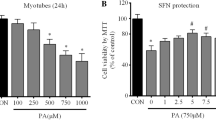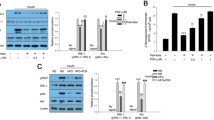Abstract
Curcumin, a natural polyphenol compound, has the beneficial effects on several diseases such as metabolic syndrome, cancer, and diabetes. The anti-inflammatory property of curcumin has been demonstrated in different cells; however, its role in prevention of palmitate-induced inflammation in skeletal muscle C2C12 cells is not known. In this study, we examined the effect of curcumin on the inflammatory responses stimulated by palmitate in C2C2 cells. The results showed that palmitate upregulated the mRNA expression and protein release of IL-6 and TNF-α cytokines in C2C12 cells, while pretreatment with curcumin was able to attenuate the effect of palmitate on inflammatory cytokines. The anti-inflammatory effect of curcumin was associated with the repression of phosphorylation of IKKα-IKKβ, and JNK. Palmitate also caused an increase in reactive oxygen species (ROS) level that curcumin abrogated it. Collectively, these findings suggest that curcumin may represent a promising therapy for prevention of inflammation in skeletal muscle cells.




Similar content being viewed by others
Abbreviations
- FFA:
-
Free fatty acids
- TNF-α:
-
Tumor necrosis factor alpha
- IL-6:
-
Interleukin 6
- CRP:
-
C-reactive protein
- IL-1β:
-
Interleukin 1β
- LPS:
-
Lipopolysaccharide
- NF-κB:
-
Nuclear factor kappa-light-chain-enhancer of activated B cells
- IKK:
-
IκB kinase
- MAPK:
-
Mitogen-activated protein kinase
- JNK:
-
c-Jun N-terminal kinase
- ERK:
-
Extracellular signal-regulated kinase
- ROS:
-
Reactive oxygen species
- T2D:
-
Type 2 diabetes
- IκB:
-
Nuclear factor of kappa light polypeptide gene enhancer in B-cells inhibitor
References
Barma P et al (2009) Lipid induced overexpression of NF-κB in skeletal muscle cells is linked to insulin resistance. Biochim Biophys Acta 1792:190–200
Boden G, Shulman G (2002) Free fatty acids in obesity and type 2 diabetes: defining their role in the development of insulin resistance and β-cell dysfunction. Eur J Clin Invest 32:14–23
Coll T et al (2008) Oleate reverses palmitate-induced insulin resistance and inflammation in skeletal muscle cells. J Biol Chem 283:11107–11116
Deng Y-T, Chang T-W, Lee M-S, Lin J-K (2012) Suppression of free fatty acid-induced insulin resistance by phytopolyphenols in C2C12 mouse skeletal muscle cells. J Agric Food Chem 60:1059–1066
Devi YS, DeVine M, DeKuiper J, Ferguson S, Fazleabas AT (2015) Inhibition of IL-6 signaling pathway by curcumin in uterine decidual cells. PLoS ONE 10:e0125627
Frost RA, Nystrom GJ, Lang CH (2002) Lipopolysaccharide regulates proinflammatory cytokine expression in mouse myoblasts and skeletal muscle. Am J Physiol-Regul Integr Comp Physiol 283:R698–R709
Fu Y, Zheng S, Lin J, Ryerse J, Chen A (2008) Curcumin protects the rat liver from CCl4-caused injury and fibrogenesis by attenuating oxidative stress and suppressing inflammation. Mol Pharmacol 73:399–409
Geng S et al (2017) Curcumin attenuates BPA-induced insulin resistance in HepG2 cells through suppression of JNK/p38 pathways. Toxicol Lett 272:75–83
Gupta SC, Patchva S, Aggarwal BB (2013) Therapeutic roles of curcumin: lessons learned from clinical trials. AAPS J 15:195–218
Inoguchi T et al (2000) High glucose level and free fatty acid stimulate reactive oxygen species production through protein kinase C—dependent activation of NAD (P) H oxidase in cultured vascular cells. Diabetes 49:1939–1945
Khan IM et al (2015) Intermuscular and perimuscular fat expansion in obesity correlates with skeletal muscle T cell and macrophage infiltration and insulin resistance. Int J Obes 39:1607
Khodabandehloo H, Gorgani-Firuzjaee S, Panahi G, Meshkani R (2016) Molecular and cellular mechanisms linking inflammation to insulin resistance and beta-cell dysfunction. Transl Res 167:228–256. https://doi.org/10.1016/j.trsl.2015.08.011
Klotz LO, Pellieux C, Briviba K, Pierlot C, Aubry JM, Sies H (1999) Mitogen-activated protein kinase (p38-, JNK-, ERK-) activation pattern induced by extracellular and intracellular singlet oxygen and UVA. FEBS J 260:917–922
Kowluru RA, Kanwar M (2007) Effects of curcumin on retinal oxidative stress and inflammation in diabetes. Nutr Metab 4:8
Koyama T et al (2011) SIRT3 attenuates palmitate-induced ROS production and inflammation in proximal tubular cells. Free Radical Biol Med 51:1258–1267
Kuhad A, Pilkhwal S, Sharma S, Tirkey N, Chopra K (2007) Effect of curcumin on inflammation and oxidative stress in cisplatin-induced experimental nephrotoxicity. J Agric Food Chem 55:10150–10155
Lang CH, Silvis C, Deshpande N, Nystrom G, Frost RA (2003) Endotoxin stimulates in vivo expression of inflammatory cytokines tumor necrosis factor alpha, interleukin-1β,-6, and high-mobility-group protein-1 in skeletal muscle. Shock 19:538–546
Lawrence T (2009) The nuclear factor NF-κB pathway in inflammation. Cold Spring Harbor Perspect Biol 1:a001651
Ma F, Liu F, Ding L, You M, Yue H, Zhou Y, Hou Y (2017) Anti-inflammatory effects of curcumin are associated with down regulating microRNA-155 in LPS-treated macrophages and mice. Pharm Biol 55:1263–1273
Maithilikarpagaselvi N, Sridhar MG, Swaminathan RP, Zachariah B (2016) Curcumin prevents inflammatory response, oxidative stress and insulin resistance in high fructose fed male Wistar rats: potential role of serine kinases. Chem Biol Interact 244:187–194
Maloney E et al (2009) Activation of NF-κB by palmitate in endothelial cells. Arterioscler Thromb Vasc Biol 29:1370–1375
Martins AR et al (2012) Mechanisms underlying skeletal muscle insulin resistance induced by fatty acids: importance of the mitochondrial function. Lipids Health Dis 11:30
Meshkani R, Vakili S (2016) Tissue resident macrophages: key players in the pathogenesis of type 2 diabetes and its complications. Clinica Chimica Acta 462:77–89. https://doi.org/10.1016/j.cca.2016.08.015
Na L-X, Zhang Y-L, Li Y, Liu L-Y, Li R, Kong T, Sun C-H (2011) Curcumin improves insulin resistance in skeletal muscle of rats. Nutr Metab Cardiovasc Dis 21:526–533
Nakamura S et al (2009) Palmitate induces insulin resistance in H4IIEC3 hepatocytes through reactive oxygen species produced by mitochondria. J Biol Chem 284:14809–14818
Panahi Y, Sahebkar A, Parvin S, Saadat A (2012) A randomized controlled trial on the anti-inflammatory effects of curcumin in patients with chronic sulphur mustard-induced cutaneous complications. Ann Clin Biochem 49:580–588
Panahi Y, Hosseini MS, Khalili N, Naimi E, Majeed M, Sahebkar A (2015) Antioxidant and anti-inflammatory effects of curcuminoid-piperine combination in subjects with metabolic syndrome: a randomized controlled trial and an updated meta-analysis. Clin Nutr 34:1101–1108
Park JM, Lee JS, Song JE, Sim YC, Ha S-J, Hong EK (2015) Cytoprotective effect of hispidin against palmitate-induced lipotoxicity in C2C12 myotubes. Molecules 20:5456–5467
Pillon NJ, Arane K, Bilan PJ, Chiu TT, Klip A (2012) Muscle cells challenged with saturated fatty acids mount an autonomous inflammatory response that activates macrophages. Cell Commun Signal 10:30
Reaven GM (1991) Insulin resistance and compensatory hyperinsulinemia: role in hypertension, dyslipidemia, and coronary heart disease. Am Heart J 121:1283–1288
Sadeghi A, Ebrahimi S, Sadat S, Golestani A, Meshkani R (2017) Resveratrol ameliorates palmitate-induced inflammation in skeletal muscle cells by attenuating oxidative stress and JNK/NF-κB pathway in a SIRT1-independent mechanism. J Cell Biochem 118(9):2654–2663
Shao-Ling W, Ying L, Ying W, Yan-Feng C, Li-Xin N, Song-Tao L, Chang-Hao S (2009) Curcumin, a potential inhibitor of up-regulation of TNF-alpha and IL-6 induced by palmitate in 3T3-L1 adipocytes through NF-kappaB and JNK pathway. Biomed Environ Sci 22:32–39
Sharma R, Gescher A, Steward W (2005) Curcumin: the story so far. Eur J Cancer 41:1955–1968
Tak PP, Firestein GS (2001) NF-κB: a key role in inflammatory diseases. J Clin Investig 107:7–11
Varma V et al (2009) Muscle inflammatory response and insulin resistance: synergistic interaction between macrophages and fatty acids leads to impaired insulin action. Am J Physiol-Endocrinol Metab 296:E1300–E1310
Varma SR, Sivaprakasam TO, Mishra A, Prabhu S, Rafiq M, Rangesh P (2017) Imiquimod-induced Psoriasis-like inflammation in differentiated Human keratinocytes: its evaluation using curcumin. Eur J Pharmacol 813:33–41
Xu Y, Liu L (2017) Curcumin alleviates macrophage activation and lung inflammation induced by influenza virus infection through inhibiting the NF-κB signaling pathway. Influenza Respir Viruses 11(5):457–463
Yang M et al (2013) Saturated fatty acid palmitate-induced insulin resistance is accompanied with myotube loss and the impaired expression of health benefit myokine genes in C2C12 myotubes. Lipids Health Dis 12:104
Zhang J, Wang X, Vikash V, Ye Q, Wu D, Liu Y, Dong W (2016) ROS and ROS-mediated cellular signaling. Oxid Med Cell Longev. https://doi.org/10.1155/2016/4350965
Acknowledgements
This work was financially supported by a Grant (96-04-30-36707) from the Deputy of Research, Tehran University of Medical Sciences.
Author information
Authors and Affiliations
Corresponding author
Ethics declarations
Conflict of interest
The authors have nothing to declare.
Rights and permissions
About this article
Cite this article
Sadeghi, A., Rostamirad, A., Seyyedebrahimi, S. et al. Curcumin ameliorates palmitate-induced inflammation in skeletal muscle cells by regulating JNK/NF-kB pathway and ROS production. Inflammopharmacol 26, 1265–1272 (2018). https://doi.org/10.1007/s10787-018-0466-0
Received:
Accepted:
Published:
Issue Date:
DOI: https://doi.org/10.1007/s10787-018-0466-0




